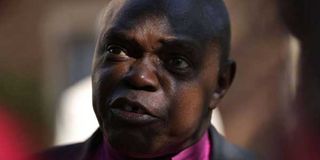UK archbishop puts collar back on after Mugabe’s fall

This file photo taken on July 27, 2017 shows Archbishop of York, John Sentamu speaking during an interview after a memorial service for five of the Grenfell Tower victims, outside St Helen's Church in west London on July 27, 2017. The Archbishop put on his dog collar on November 26, 2017, for the first time since cutting it up ten years ago in protest at Robert Mugabe's rule. AFP PHOTO | DANIEL LEAL-OLIVAS
What you need to know:
- On the BBC show 10 years ago, he held up his collar, saying it was what he wore to identify himself as a clergyman.
- Mugabe’s nephew said today the ousted Zimbabwean president was in good health.
LONDON
The Archbishop of York, John Sentamu, put on his white cleric’s collar today for the first time since cutting it up 10 years ago in a highly symbolic protest at Robert Mugabe’s rule.
The Uganda-born cleric, the second most senior clergyman in the Church of England, made the dramatic gesture on live television in 2007, and stated that he would not wear it again until the Zimbabwe president was gone.
NEW
After Mugabe left office this week, Sentamu appeared on the same BBC programme where he was handed the pieces of his collar, only to pull a new one out of his pocket and put it on.
“I think the lesson for Zimbabwe is the same. They just can’t try and stitch it up. Something more radical, something new has to happen in terms of the rule of law, allowing people to get jobs,” he told the Andrew Marr show.
He added: “I promised when Mugabe goes I (would) put my collar on, so I have no choice but to put it back on. And Mugabe has gone but the new president has to remember something more new than simply stitching up a thing will work.”
SEEK FORGIVENESS
Sentamu said Zimbabwe needed a kind of truth and reconciliation commission like that seen in South Africa — and said Mugabe should ask for forgiveness.
“Mugabe at some point needs to say, 'people of Zimbabwe, 37 years (ago) I took on a country that was fantastic, I nearly took it to ruin. Zimbabweans forgive me’,” he said.
Many Zimbabweans have celebrated Mugabe’s departure but fear new President Emmerson Mnangagwa — until recently one of Mugabe’s closest allies — could also lead an authoritarian regime.
Sentamu said: “It is quite possible that Emmerson Mnangagwa could actually be a very, very good president. But he can’t simply bury the past. It won’t go away.”
IDENTITY
The 68-year-old became the Church of England’s first black archbishop when he was enthroned in November 2005.
On the BBC show 10 years ago, he held up his collar, saying it was what he wore to identify himself as a clergyman.
“You know what Mugabe has done? He’s taken people’s identity, and literally, if you don’t mind, cut it to pieces, and in the end there’s nothing,” he said, snipping it into bits with scissors.
GOOD HEALTH
Meanwhile, Mr Mugabe’s nephew said today the ousted Zimbabwean president was in good health and “quite jovial” after being forced to resign when a military takeover ended his 37 years in power.
“He is fine. I have been to see him, he is quite jovial,” Leo Mugabe, son of Mugabe’s late sister Sabina, told AFP.
“He is actually looking forward to his new life, farming and staying at the rural home. He has taken it well.”
Leo Mugabe declined to discuss the $10-million retirement bonus reportedly granted to the 93-year-old former president as part of a deal to persuade him to eventually resign last Tuesday.
PLANS
He added that Robert Mugabe’s wife Grace was now concentrating on plans to build a university in his honour.
“I like the spirit she has, she is with him all the time. She is an amazing person. She wants to continue planning the Robert Mugabe University so they have something to do,” he said.
In August, Zimbabwe announced plans to build the $1-billion post-graduate university in Mazowe, 35 kilometres (20 miles) outside Harare.
The plan drew fierce criticism as Mugabe is accused of brutal repression and bringing the country to economic ruin.





